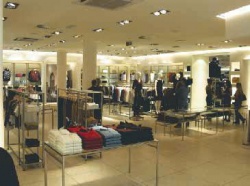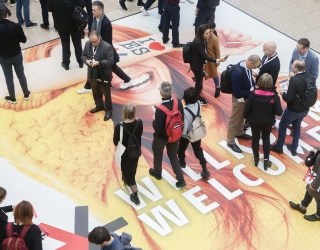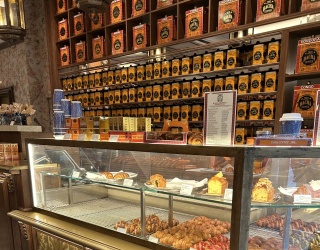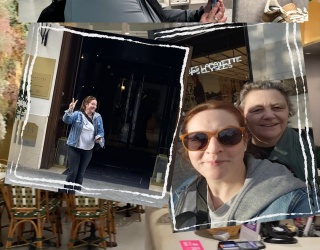
Light can subconsciously influence people, positively as well as negatively. Sunlight makes people happy and in the dark months of winter depressions are more common than in the rest of the year. But aside from such extreme effects, the psychological influence of lighting can also be used for shop design. It helps create an individual atmosphere and buying incentives.
Effective lighting does not only mean to install lights that are as bright as possible: Careful planning is crucial to create the desired effects. And aside from giving a shop an own atmosphere, there are also practical uses: Differentiated lighting helps the customers to orient themselves inside the shop, different levels of brightness show the way between different product selections. Light supports the perception of a customer, without making him feel being driven to make any particular decision. This is because light and colors affect him on a subconscious level. Nonetheless, they are forming a room.
„Vertical lighting should not be disregarded easily when it comes to orientation and guidance” as the luminaire manufacturer Erco points out in a brochure. “Flooded with light, the back wall shows the customer the dimensions of a sales room. The vertical illumination of displays and decorations proves to be a useful guide between product groups, especially when a large and diverse range of goods is on display on the sales floor.”
Creating atmosphere, observing rules and regulations
Good lighting is more than just an assistance for the customer: A harmonious lighting atmosphere promotes a sense of well-being and makes working with and for the customer easier for employees. Additionally, it is part of the corporate identity and thus tributes to company success. But when planning an individual lighting solution, planners have to thread the way between the desired effects and the legal requirements: The levels of illuminance and luminance prescribed in standards have to be complied with, without adversely affecting the desired atmosphere.
Research nowadays distinguishes between three different concepts of light:
- Light to see: It provides a uniform background brightness, an adequate level of illumination and low glare. Goods and their environment become visible and orientation is made easier.
- Light for looking: Individual areas and promotion areas are highlighted and distinguished from their surroundings. This accentuated lighting directs the eye of the observer to the products, highlighting their individual properties. For this purpose, pools of light are generated, within which the level of lighting is well above the level of the ambient lighting.
- Light for viewing: This is a special kind of accentuated lighting, where the light is itself an object of perception. Examples are colored light, running lights or moving beams.
Important factors of lighting planning are light color and color reproduction, as well as the properties of the light sources. The design of the light sources and a successful play with light and shadows also play an important role.
Experts recommend using a warm lighting in shops. Glaring cold light reminds many people of the sterile atmosphere of a hospital and makes the shop look not very inviting. To avoid discomforting the customer and instead even positively influence his purchase decision, lighting should be bright and uniform and should show the authentic colors of the products. An attractive source of light at the entrance drives the customer’s attention to the store in the first place. Ambient lighting alone is not enough and hardly has a positive influence on buying decisions. Only the right lighting accents show the products in the right way.
Influence of illuminance and luminance
Illuminance and luminance properties of the light sources determine the „color climate“, which itself has an influence on mood and well-being of a person - and thus his willingness to buy at the store. Three colors of light are distinguished: warm-white light colors, neutral-white light colors and daylight-white light colors. According to the concept of the sales room, the choice of the color of light is crucial. Generally applies: the more exclusive, the warmer (warm-white) the color of the light - and vice versa: the less expensive the offer, the colder (neutral-white or daylight-white) the light.
Every source of light has a special color reproduction, which means the property of a light to reproduce the colors and contrasts of color of an object. Color reproduction is especially important where the promotional emphasis is on color fastness. This applies especially in the fashion and textile sector.
LED offers new possibilities for staging lighting scenes
The new flexibility of modern lamps is ideally suited to create dramatic lighting, and thereby create desires. It is possible to specifically refer to the composition and quality of the products as to convey emotions and moods. Dynamic lighting solutions are made possible by using dimmable LED lights with very high color rendering and color stability as well as a wide range of shades of white.
With variable lighting temperatures, subtle light stimuli can be achieved, for example those which are typically for a daytime or a time of year. Intelligent lighting design also utilizes daylight. This means that the goods are staged according to outside brightness: Intense accentuated light provides a high contrast, flat light lures the customer into the depth of the room on cloudy days and at dusk.
Addressing individual customers with modern light design
Another possibility is the direct targeting of individual customers using modern technologies and an intelligent lighting control. An example: A young male customer walks past a shop window. At that precise moment, a hidden spot light turns on and directly illuminates a pair of sneakers in the window display. This works by combining the light control with modern video cameras and analysis algorithms. The cameras detect the consumer’s direction of view and are often also able to estimate age and gender. The product deemed most interesting for someone this age and gender is then presented in a special manner using accentuated lighting. This way it is possible - even within the store – to directly target individual consumers and raise their awareness of diverse products which could be especially interesting for them.
Influence of light on consumption is scientifically proven
A specific lighting design combined with the latest technical innovations can stimulate consumption pattern of the prospective buyer. Before every other promotional measure, it is the light effects which are intended to stimulate the customer to buy. Their effectiveness has been proven again by recent studies: In a psychological test the research division of Philips has carried out with 100 subjects, it was observed that "the customers, who were in a colorful scenario full of light effects, stayed in the store much longer than those in a neutral lighting scenario," said psychologist Jettie Hoonhout. How long customers stay in the store is extremely important, because all relevant studies also show: Customers who spend a lot of time in a store tend to buy more. And a feeling of well-being, triggered by intelligent lighting, can extend the period of their stay accordingly.
Daniel Stöter, iXtenso.com








